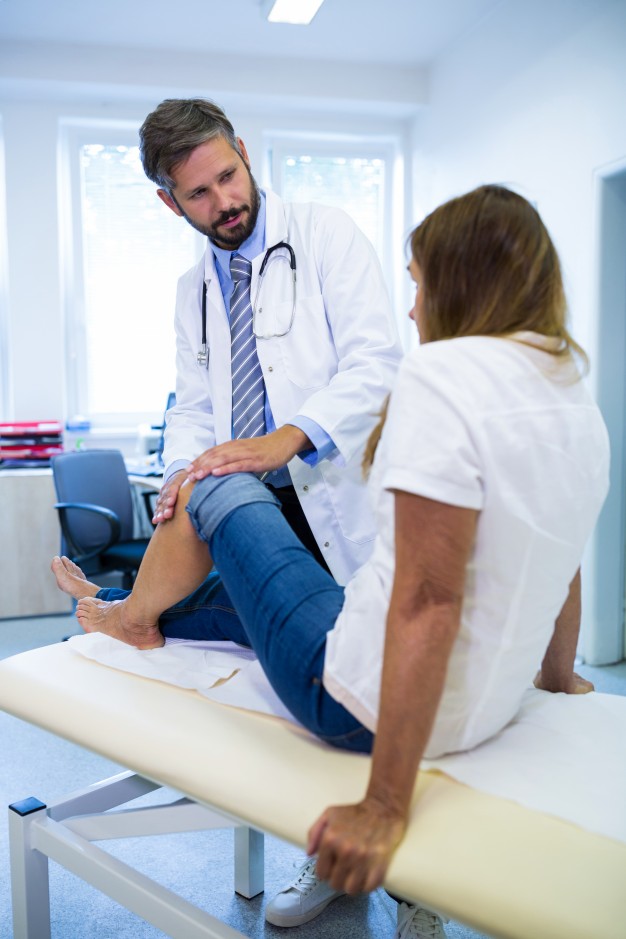1. On the Road to Recovery
When it comes to knee replacement surgery, the procedure itself, while obviously important, is just one step in the process. What happens after the surgery—the recovery and rehabilitation—is just essential to the overall success of the procedure.

Here are some strategies to help guide you through recovery and rehabilitation.
2. Take Your Recovery and Rehab Seriously
It’s important to not let your routine slide. Use your continuous passive motion (CPM) machine as advised by your doctor, and perform all the exercises your physical therapist prescribes. Attend your follow-up appointments with your surgeon and go to all your physical therapy sessions, even when you don’t feel like it. Take medications as prescribed and do not stop any medication without checking with your doctor.
3. Improve Your Extension and Flexion
Bend and straighten your leg as much as possible. One way to improve your extension is to lay down, with a rolled towel placed underneath your ankle while lying down—try to keep your leg as straight as possible. You can improve your flexion by sitting on a chair and bending your knee back (i.e., curling your leg underneath the seat of the chair). Also, talk to your physical therapist to learn if they recommend continuing use of the CPM machine to help you expand your range of motion.
4. Avoid Unnecessary Stress on Your Knee
Avoid lifting heavy objects that could place an excessive amount of stress on your artificial knee—and possibly damage it. Also, when you turn to face a different direction, make sure you turn your entire body and avoid twisting your knee pain. It is important to monitor your form when you bend down, kneel, and sit. Perform these regular movements with your physical therapist, so that he or she can help you learn how to do them safely and efficiently.
5. Take Recommended Supplements and Vitamins
Talk to your doctor about vitamins or supplements that might help. One study found that 43 percent of patients scheduled to undergo orthopaedic surgeon have insufficient levels of vitamin D. Also, many orthopedic patients take iron to help replenish blood count after surgery. Since you might be compensating with your non-operated knee during the early stages of rehab, you may want to consider supplements that can aid in muscle recovery.
6. Wear Compression Stockings
If your doctor suggests that you wear compression stockings post-surgery, keep them on at night or while lying down. They can help reduce the risk of blood clots. Make sure you wear them until your doctor says that it’s okay to stop.
7. Keep the Ice and Heat On
Icing your knee replacement can reduce inflammation and pain. It is particularly effective for the first several days after surgery and during any flare up. After the initial swelling has decreased, you can alternate ice and heat—which relaxes the muscles and eases stiffness.
8. Minimize or Avoid Alcohol & Smoking
Avoid drinking alcohol if you are taking a blood thinner such as warfarin (Coumadin) or taking any narcotic pain medication. If you smoke, make an effort to cut back or stop. Smoking shrinks your blood vessels, which makes the healing process slower. Healthier lungs lead to higher blood oxygen levels—and faster healing.
9. Watch Your Weight
Keep your weight down. Extra pounds put greater pressure on your new knee Surgery, and can slow your recovery. Also, if you are overweight you can risk developing osteoarthritis in your other knee. Learn more about the connection between your weight and your new knee.
10. Go for Walks and Exercise Sensibly
Walking and exercise help strengthen the muscles in your legs and improve overall blood flow. Take outside walks as soon as possible and increase the distance a bit each day. Moving around the house doesn’t provide enough exercise. In addition, as your knee grows stronger, consider low impact activities like swimming, golf, gardening, and peddling on a stationary bike to aid in rehab.
11. Avoid High Impact Activities
As your knee grows stronger you may be tempted to resume your favorite sports. However, high impact activities like running, downhill skiing, and vigorous court games could cause serious pain and problems or damage your prosthetic device. Explore ways in which you can engage in the sports you like, without excessive impact. For example, try power walking instead of running, or doubles instead of singles tennis.
Source Content By – healthline

